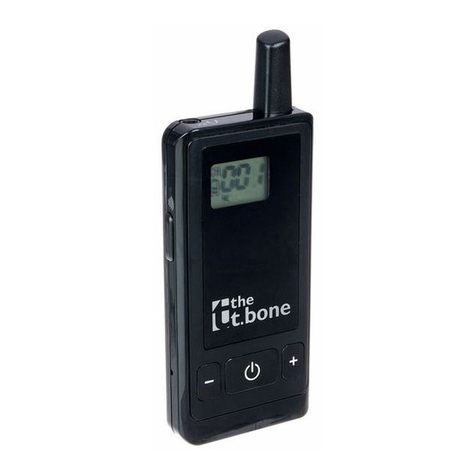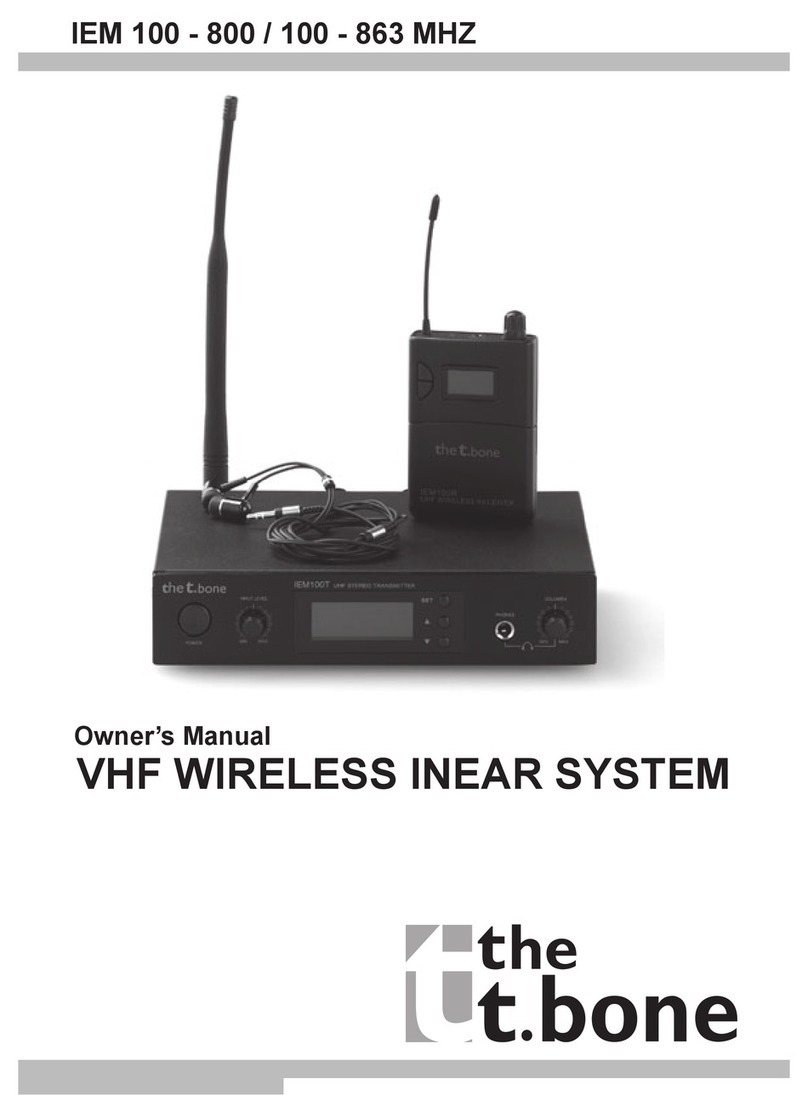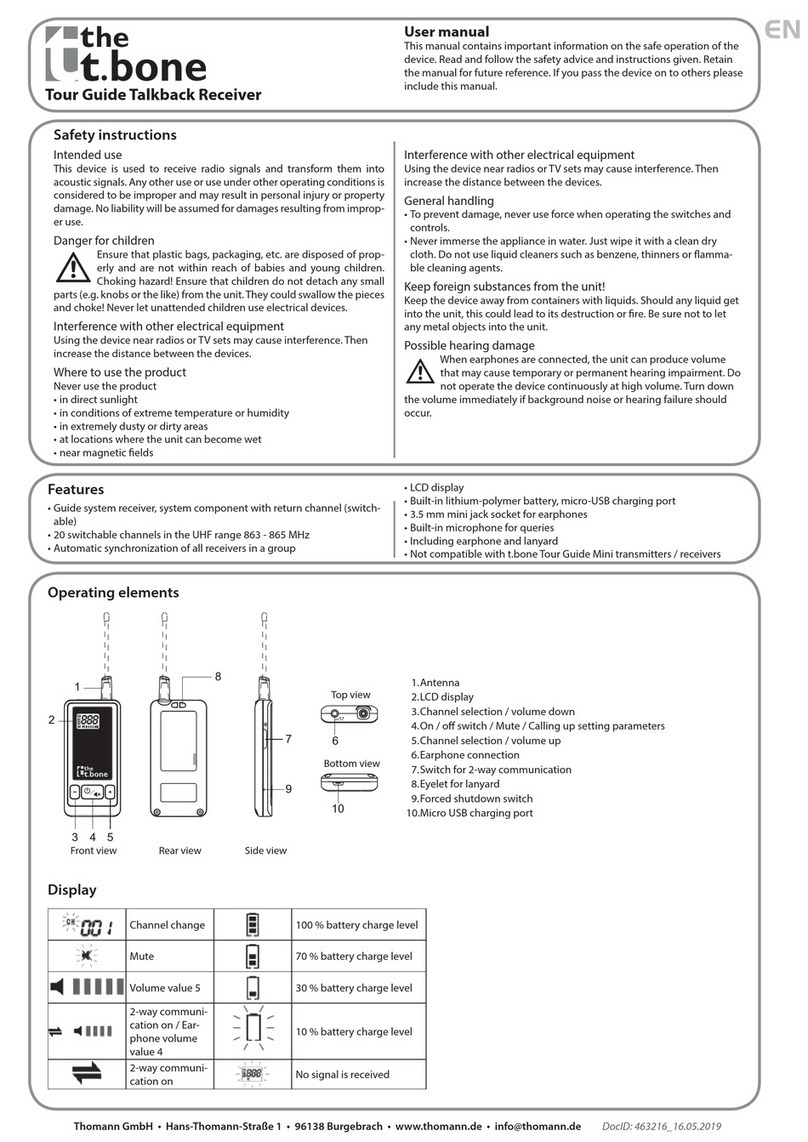
Thomann
GmbH
•
Hans-
Thomann-Straße
1
•
96138
Burgebrach
•
www
.thomann.de
•
[email protected] DocID: 478776_28.04.2021EN
Wireless Plug & Play
Quick Start Guide
This quick start guide contains important information on the safe operation of the
product. Read and follow the safety advice and instructions given. Retain the quick
start guide for future reference. If you pass the product on to others please include
this quick start guide.
Safety instructions
Intended use
This device is used for the wireless transmission of audio signals. Any other use or use
under other operating conditions is considered to be improper and may result in per-
sonal injury or property damage. No liability will be assumed for damages resulting
from improper use.
Danger for children
Ensure that plastic bags, packaging, etc. are disposed of properly and are
not within reach of babies and young children. Choking hazard! Ensure
that children do not detach any small parts (e.g. knobs or the like) from
the unit. They could swallow the pieces and choke! Never let unattended
children use electrical devices.
Notes on wireless transmission
The system works in the frequency range 5.729 GHz… 5.820 GHz and is free of
charge and registration worldwide.
This device utilizes frequencies that are not harmonized within the European Union
(EU) and therefore may only be used in certain EU member states. In all European
countries, the frequencies used for the transmission of audio signals are strictly regu-
lated. Before you start, make sure the frequencies are allowed in the respective coun-
try and check whether the operation must be reported to the appropriate authority.
For more information, please visit: http://www.thomann.de.
• Make sure that transmitter and receiver are both tuned to the same channel.
• Never set multiple transmitters to the same channel.
• Make sure that there are no metal objects between the transmitter and receiver.
• Avoid interference from other radio or in-ear systems.
Incorrect handling of lithium batteries can result in injury
• In the event of a short circuit, overheating or mechanical damage, lithium batteries
can cause severe injuries.
• When handled correctly and appropriately lithium batteries pose no risk.
• Store lithium batteries in a cool, dry place, ideally in the original packaging.
• Store lithium batteries away from heat sources (e.g. radiators or sunlight). Lithium
batteries are hermetically sealed. Never attempt to open a lithium battery.
• If the battery housing is damaged small amounts of the electrolyte may leak out. If
this should happen, seal the lithium battery in airtight packaging and wipe up the
traces of electrolyte using absorbent paper towels. You must wear protective rub-
ber gloves when doing so. Clean your hands and the aected surface thoroughly
with cold water.
• Never attempt to recharge non-rechargeable lithium batteries. When charging lit-
hium batteries you must use a suitable charging device intended for the purpose.
• Before disposing of the device remove the lithium batteries. Protect used lithium
batteries against potential short circuits, e.g. by covering the poles with adhesive
tape.
• Only use powder extinguishers or other suitable extinguishing agents to extingu-
ish a burning lithium battery.
Possible damage to lithium-ion batteries through incorrect storage
By deep discharge, lithium-ion batteries can be permanently damaged or lose
some of their capacity.
Before long breaks, charge the batteries to around 50 % of their capacity and then
switch o the device. Store the device at room temperature or cooler in an environ-
ment as dry as possible. If the batteries are stored for a longer period, recharge
them to 50 % every three months.
Fully charge the batteries only shortly before use at room temperature.
Where to use the product
Never use the product
• in direct sunlight
• in conditions of extreme temperature or humidity
• in extremely dusty or dirty areas
• at locations where the unit can become wet
• near magnetic elds
General handling
• To prevent damage, never use force when operating the switches and controls.
• Never immerse the appliance in water. Just wipe it with a clean dry cloth. Do not
use liquid cleaners such as benzene, thinners or ammable cleaning agents.
Electromagnetic compatibility other electrical equipment
Using the device near radios or TV sets may cause interference. Then increase the
distance between the devices.
Keep foreign substances from the unit!
Keep the device away from containers with liquids. Should any liquid get into the
unit, this could lead to its destruction or re. Be sure not to let any metal objects
into the unit.
Features
• XLR plug-on transmitter and receiver
• Radio system in the range from 5.729GHz to 5.820GHz
• Charging cable USB-A to 2 × Micro-USB included
• 4 preset frequencies
• Optional USB power supply available: 278119
Operating elements and connections
Rear view Front view öMicro USB power recharging port
#Transmitter: XLR socket
Receiver: XLR plug
$Release button, push to disconnect from microphone (transmitter only)
%Indicator (orange)
&ID channel indicator and power level indicator. The 4 dierent colours stand
for the four available communication channels.
äPower button
(ID button



























